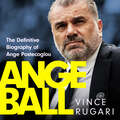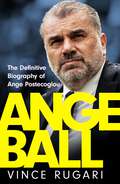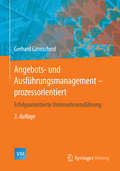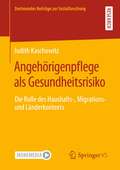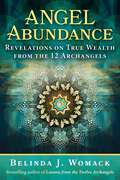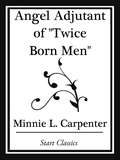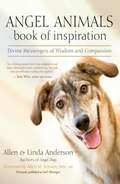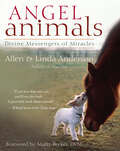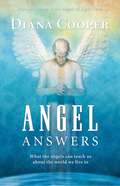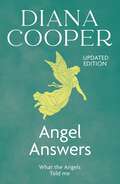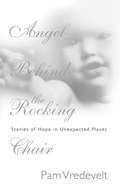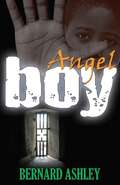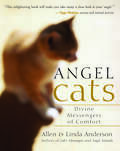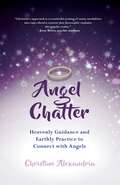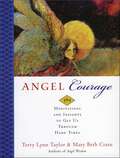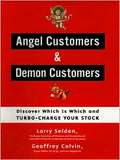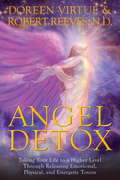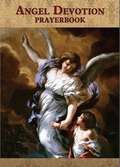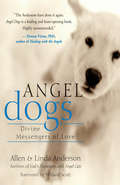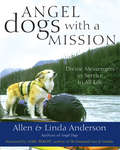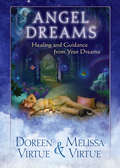- Table View
- List View
Angavikalara Hakkugala kaide 2016
by Government IndiaAngavikalara Hakkugala kaide 2016, National Center for Promotion of Employment for Disabled People
Angeball: The Definitive Biography of Ange Postecoglou
by Vince RugariThe definitive biography and ultimate origin story of Ange Postecoglou, the Premier League's most intriguing new manager and instigator of the 'Angeball' phenomenon that has taken the football world by storm.It has taken no time at all for fans of Tottenham Hotspur to fall completely in love with Ange Postecoglou and his 'Angeball' brand of front-foot football. To those who have followed his intriguing journey - from a five-year-old Greek immigrant, to a marauding left-back in the Australian National Soccer League, to a pioneering coach who has won trophies on three different continents - it is no surprise at all. 'Big Ange' did the same thing in Glasgow with Celtic (five trophies in two seasons), and in Japan with Yokohama F Marinos.Before that, he claimed four titles with his boyhood club South Melbourne, travelled the globe with Australia's junior national teams, set a national record with a 36-game unbeaten streak at Brisbane Roar, and guided the 'Socceroos' to their greatest achievement, winning the Asian Cup in 2015. Fuelled by an unshakable belief in himself and his ideas, Postecoglou's unique, mesmerising style of football is inspired by the kind of teams he would enjoy watching as a child with his father. And it works. It turns sceptics into believers and then into full-blown disciples.Drawing on dozens of interviews with Postecoglou and his players, coaches, colleagues, friends and foes, and reams of archival material, Angeball delves into the heart and soul of a man who has reshaped the football landscape. It explores the dynamics behind his coaching brilliance, his complicated relationship with the game in his homeland, and the profound impact he has had on fans worldwide.
Angeball: The Definitive Biography of Ange Postecoglou
by Vince RugariThe definitive biography and ultimate origin story of Ange Postecoglou, the Premier League's most intriguing new manager and instigator of the 'Angeball' phenomenon that has taken the football world by storm.It has taken no time at all for fans of Tottenham Hotspur to fall completely in love with Ange Postecoglou and his 'Angeball' brand of front-foot football. To those who have followed his intriguing journey - from a five-year-old Greek immigrant, to a marauding left-back in the Australian National Soccer League, to a pioneering coach who has won trophies on three different continents - it is no surprise at all. 'Big Ange' did the same thing in Glasgow with Celtic (five trophies in two seasons), and in Japan with Yokohama F Marinos.Before that, he claimed four titles with his boyhood club South Melbourne, travelled the globe with Australia's junior national teams, set a national record with a 36-game unbeaten streak at Brisbane Roar, and guided the 'Socceroos' to their greatest achievement, winning the Asian Cup in 2015. Fuelled by an unshakable belief in himself and his ideas, Postecoglou's unique, mesmerising style of football is inspired by the kind of teams he would enjoy watching as a child with his father. And it works. It turns sceptics into believers and then into full-blown disciples.Drawing on dozens of interviews with Postecoglou and his players, coaches, colleagues, friends and foes, and reams of archival material, Angeball delves into the heart and soul of a man who has reshaped the football landscape. It explores the dynamics behind his coaching brilliance, his complicated relationship with the game in his homeland, and the profound impact he has had on fans worldwide.
Angeball: The Definitive Biography of Ange Postecoglou
by Vince RugariThe definitive biography and ultimate origin story of Ange Postecoglou, the Premier League's most intriguing new manager and instigator of the 'Angeball' phenomenon that has taken the football world by storm.It has taken no time at all for fans of Tottenham Hotspur to fall completely in love with Ange Postecoglou and his 'Angeball' brand of front-foot football. To those who have followed his intriguing journey - from a five-year-old Greek immigrant, to a marauding left-back in the Australian National Soccer League, to a pioneering coach who has won trophies on three different continents - it is no surprise at all. 'Big Ange' did the same thing in Glasgow with Celtic (five trophies in two seasons), and in Japan with Yokohama F Marinos.Before that, he claimed four titles with his boyhood club South Melbourne, travelled the globe with Australia's junior national teams, set a national record with a 36-game unbeaten streak at Brisbane Roar, and guided the 'Socceroos' to their greatest achievement, winning the Asian Cup in 2015. Fuelled by an unshakable belief in himself and his ideas, Postecoglou's unique, mesmerising style of football is inspired by the kind of teams he would enjoy watching as a child with his father. And it works. It turns sceptics into believers and then into full-blown disciples.Drawing on dozens of interviews with Postecoglou and his players, coaches, colleagues, friends and foes, and reams of archival material, Angeball delves into the heart and soul of a man who has reshaped the football landscape. It explores the dynamics behind his coaching brilliance, his complicated relationship with the game in his homeland, and the profound impact he has had on fans worldwide.
Angebots- und Ausführungsmanagement-prozessorientiert: Erfolgsorientierte Unternehmensführung (VDI-Buch)
by Gerhard GirmscheidDie zwischen Angebot und Auftragsabwicklung im Bauunternehmen entstehenden Probleme lassen sich vermeiden. In diesem Buch findet der Leser das Angebots- und Ausf#65533;hrungsmanagement systematisch strukturiert. Die Projektphasen des Angebotsmanagements( Akquisition, Angebotsbearbeitung und Vertragsverhandlungen) sowie des Ausf#65533;hrungsmanagements (Arbeitsvorbereitung, Beschaffung und Bauausf#65533;hrung) werden in den einzelnen Schritten dargelegt. Im Vordergrund stehen die Prozessverantwortung sowie eine zielorientierte Arbeitsplanung und Arbeitsorganisation f#65533;r eine ergebnisorientierte Takt- und Fliessplanung mit Bauprogramm, Arbeitskalkulation, Wochen- und Tagesplanung, Logistik, Qualit#65533;ts- und Nachtragsmanagement. Alle wichtigen Aufgaben der Beteiligten werden beschrieben. Das Buch dient als Leitfaden f#65533;r eine erfolgreiche, prozess- und ergebnisorientierte Projektabwicklung in Bauunternehmen zur Erzielung des kalkulierten Gewinns und einer hohen Kundenzufriedenheit. Die #65533;berarbeitungen und Erg#65533;nzungen machen diese Neuauflage zu einem umfassenden Planungs- und Steuerungshandbuch f#65533;r die Angebots- und Ausf#65533;hrungsbearbeitung von projektspezifischen unikaten Auftr#65533;gen.
Angehörigenpflege als Gesundheitsrisiko: Die Rolle des Haushalts-, Migrations- und Länderkontexts (Dortmunder Beiträge zur Sozialforschung)
by Judith KaschowitzDie Versorgung pflegebedürftiger Angehöriger ist eine der wichtigsten Aufgaben unserer Zeit. Unklar ist, ob damit Gesundheitsverschlechterungen für informell Pflegende verbunden sind. Diese Arbeit geht unter Zuhilfenahme europäischer Längsschnittdaten (Survey of Health, Ageing and Retirement in Europe und English Longitudinal Study of Ageing) der Frage nach, ob informelle Pflege mit negativen Gesundheitsfolgen verbunden ist. Dabei wird berücksichtigt, dass mögliche Gesundheitsfolgen in Abhängigkeit des Ortes (innerhalb oder außerhalb des eigenen Haushalts) und Landes der Pflegeübernahme sowie der Herkunft der Pflegenden variieren können. Im Ergebnis zeigt sich, dass Pflegekonstellationen mit einer großen (emotionalen/räumlichen) Nähe zwischen Pflegenden und Gepflegten sowie in Ländern mit geringem formellen Pflegeangebot besonders belastend sind. Keine Unterschiede in den Gesundheitsfolgen von informeller Pflege zeigen sich dagegen in Abhängigkeit des Herkunftskontexts, sprich Migrationshintergrundes. Die Ergebnisse machen sozialpolitischen Handlungsbedarf bei der Unterstützung Pflegender deutlich und zeigen auf, dass Wohlfahrtsstaaten Rahmenbedingungen schaffen sollten, gesundheitsschonende Angehörigenpflege zu ermöglichen.Die AutorinJudith Kaschowitz ist als Post-Doktorandin an der TU Dortmund am Lehrstuhl für Sozialstruktur und Soziologie alternder Gesellschaften tätig. Sie forscht empirisch quantitativ und international vergleichend zu Fragestellungen im Bereich der Alterns- und Gesundheitssoziologie.
Angel Abundance: Revelations on True Wealth from the 12 Archangels
by Belinda J. WomackAttract wealth and healing with the guidance of the 12 Archangels• Shares 63 healing visualizations to transform fear, resolve debt, and become receptive to the infinite bounty of the Universe• Learn how to tap in to the singing colors of the Central Sun that are mirrored in your chakras and raise your vibration to attract wealth—not only financial wealth, but anything you need to receive from Source to feel safe, happy, healthy, and free• Offers nighttime practices to support your transformation into a vessel to receive the full blessings of Source as well as advanced practices to transform sufferingYou are personally invited by the 12 Archangels to receive all that you desire from Source, especially the true happiness that often seems out of reach. Your Soul has the clear guidance and tools to help you move from lack to abundance and attract wealth and healing and the Archangels will show you how. Speaking through Belinda Womack, who has been a channel for the 12 Archangels for more than 30 years, the Angels explain that the root issue behind our lack of abundance is the fear of not enough. Sharing 64 healing visualizations, the Angels guide you to dissolve the deep subconscious layers of guilt and shame that keep you stuck in a fear-induced lack of wealth and become receptive to the infinite bounty of the Universe. Reading the visualizations from the 12 Archangels, with intention, helps you tap into the singing colors and undiluted love of the Central Sun mirrored in your chakras. The visualizations raise the vibration of your thoughts, feelings, and beliefs to attract wealth—not only financial gain but all that you need to receive from Source to feel safe, happy, healthy, and free. The 12 Archangels share lessons on the relationship between money and divine law, how to cultivate your garden of intuition and creativity, and how to resolve financial debt with understanding and love. They offer nighttime practices that support your transformation into a vessel to receive the full blessings of Source. They also offer advanced practices on harnessing your innate power to transform suffering. Helping you connect with the boundless care and &“deep pockets&” of your Soul to transform financial struggles and eliminate self-doubt, the 12 Archangels show that life keeps improving when you make room for the vast flow of creative genius and abundance coming from the Universe through the divine feminine.
Angel Adjutant of "Twice Born Men" (Start Classics)
by Minnie L. Carpenter"The Salvation Army has been happy in its Women Officers. The lessons of experience undoubtedly teach us that they are fully qualified for all the work of the ministry of Christ."
Angel Animals Book of Inspiration
by Linda Anderson Allen AndersonSome of these extraordinary true stories will make you smile and others will bring tears to your eyes, but each one will open your heart to new revelations of love in its many forms and shapes. Dogs, cats, horses, ferrets, birds, rabbits, snakes, dolphins, llamas -- the animals in this book reveal compassion, teach hope and forgiveness, or serve as a barometer to measure feelings. After reading just one of these stories, you will observe the animals in your own path with new eyes and find yourself awakening to deeper, and often startling, spiritual insights.
Angel Animals: Divine Messengers of Miracles
by Linda Anderson Allen AndersonThe animals who hold a cherished place in our hearts and homes offer inspiring lessons of patience, trust, compassion, healing, and love. The extraordinary true stories in this revised and updated edition of Angel Animals celebrate the spiritual truths we learn from animals, and remind us that miracles do happen. These surprising, heartwarming stories — about dogs, cats, horses, rabbits, raccoons, bears, birds, dolphins, deer, insects, and more — help us rise to life's challenges, find comfort in the face of loss, witness the hand of the Divine, and recognize the interconnectedness of all living things.
Angel Answers
by Diana CooperAngels provide outlooks that can help resolve any human dilemma, whether social, political, historical, personal, sexual, or spiritual, and their enlightened approaches are recorded in this insightful and uplifting spiritual guide. True and inspiring personal stories prove that no problem is too difficult when angels are consulted, and numerous exercises and meditations are included to make listening to and understanding angels easier. These simple, clear, and compassionate answers are presented as a way of resolving trying issues and finding peace.
Angel Answers
by Diana CooperIn ANGEL INSPIRATION, Diana showed us how to tap into the awesome power of the angels. In ANGEL ANSWERS she brings us lessons from the angels advising us how we should live our lives in the bewildering modern world. From relationships with children or friends to illnesses, from understanding why some people become addicted to drugs or alcohol and how to alleviate their problems, to strategies for bringing about greater equality in the world, Diana covers a vast array of the biggest questions faced by humanity.Full of the wisdom and inspiration that she has gleaned over years of angel work, ANGEL ANSWERS is the book Diana's army of fans has been waiting for and is also the perfect introduction to her writing.
Angel Answers
by Diana CooperIn ANGEL INSPIRATION, Diana showed us how to tap into the awesome power of the angels. In ANGEL ANSWERS she brings us lessons from the angels advising us how we should live our lives in the bewildering modern world. From relationships with children or friends to illnesses, from understanding why some people become addicted to drugs or alcohol and how to alleviate their problems, to strategies for bringing about greater equality in the world, Diana covers a vast array of the biggest questions faced by humanity.Full of the wisdom and inspiration that she has gleaned over years of angel work, ANGEL ANSWERS is the book Diana's army of fans has been waiting for and is also the perfect introduction to her writing.
Angel Behind the Rocking Chair
by Pam VredeveltAfter the loss of her first baby and the birth of a fourth child with Down Syndrome, Pam Vredevelt felt that she had fallen from God's grasp. As she was soon to discover, however, God was just beginning to hold her tight and lead the way out of her endless pit of despair. With humor and touching insight, Pam unveils her struggle to emerge from darkness into the light in this paperback release of her popular work. Many have been touched by the same anguish; Pam shares their stories and how the supernatural touch of God sustained them through the darkest days of life.From the Trade Paperback edition.
Angel Boy
by Bernard AshleyThe holidays lie heavy on young Leonard Boameh. His school friends live far away from his home town of Accra, his nana is no fun, and his dad -- who's great -- is away working most of the time. So Leonard decides to run away for a few hours, and when Nana isn't looking he takes the tro-tro bus to Elmina, a historic European fort built to imprison West African slaves shipped off to America. There are lots of rough kids begging there, and before Leonard knows what's happening, he is kidnapped by the meanest gang of all, who plan to use his angel-face to fleece the tourists. Leonard is now a slave, trying to escape from a living nightmare.
Angel Cats: Divine Messengers of Comfort
by Linda Anderson Allen AndersonCat lovers, your secret is out. Now everyone will know why you’re crazy over cats! Read true stories about a feline friend helping a man get his “purr” back, a cat miraculously protecting and comforting a young girl during the Holocaust, a mother-daughter cat team serving as a woman’s heart specialists, sister cats coaxing a major league baseball player through a losing season, and a cat named Cuddles who writes her own advice column. Angel Cats proves that cats are as compassionate as they are curious.
Angel Chatter: Heavenly Guidance and Earthly Practice to Connect with Angels
by Christine AlexandriaWhatever faith we personally subscribe to, angels cross those boundaries and find their way into our lives. They remind us that we are not alone; that we are all guided and protected from another world. In her new informative, quirky, and practical guide, angel intuitive and award-winning author Christine Alexandria shares her profound gifts and vast knowledge of angels.Christine details how to strengthen our connection and become empowered by the fourteen archangels with whom she chats. Chapters include the therapeutic role of each angel, the chakra system and crystals affiliated with them, guided meditations, and more. Angel Chatter enables people from all traditions and faith backgrounds to access the wisdom, joy, and power of Christine’s “haloed gang.” The angels “will flock to assist us”—this is their simple yet solemn promise.
Angel Courage: 365 Meditations and Insights to Get Us Through Hard Times
by Mary Beth Crain Terry Lynn TaylorFrom the authors of the bestselling Angel Wisdom comes a book for everyone who wants to transform fear into courage and despair into hope. This delightful book shows us how to learn from our experiences and live every day with the grace and joy of the angels. With a year's worth of daily meditations, Angel Courage offers fresh wisdom for confronting life's difficulties, both large and small-from stress at work to quarrels and letdowns, guilt and regrets, grief and grudges. Each day's reading features a thought-provoking quote, ideas for reflection, exercises, and an inspiring angel blessing. The authors encourage us to learn to love ourselves no matter what mistakes we've made. "May you always make mistakes," they advise, "just not the same ones." The wisdom of the angels shows us how to laugh at ourselves, live in the moment, put our energy into productive activities, and follow the timing of our hearts by using our own angel courage to greet each day with authenticity and love.
Angel Customers & Demon Customers
by Geoffrey Colvin Larry SeldenHow businesses can thrive by learning which customers are creating the most profit-and which are losing them money. One of the oldest myths in business is that every customer is a valuable customer. Even in the age of high-tech data collection, many businesses don't realize that some of their customers are deeply unprofitable, and that simply doing business with them is costing them money. In many places, it's typical that the top 20 percent of customers are generating almost all the profit while the bottom 20 percent are actually destroying value. Managers are missing tremendous opportunities if they are not aware which of their customers are truly profitable and which are not. According to Larry Selden and Geoff Colvin, there is a way to fix this problem: manage your business not as a collection of products and services but as a customer portfolio. Selden and Colvin show readers how to analyze customer data to understand how you can get the most out of your most critical customer segments. The authors reveal how some companies (such as Best Buy and Fidelity Investments) have already moved in this direction, and what customer-centric strategies are likely to become widespread in the coming years. For corporate leaders, middle managers, or small business owners, this book offers a breakthrough plan to delight their best customers and drive shareowner value.
Angel Detox: Taking Your Life To A Higher Level Through Releasing Emotional, Physical, And Energetic Toxins
by Doreen Virtue Robert ReevesDetoxing with the help of your angels is a gentle way to release impurities from your body, fatigue, and addictions. Doreen Virtue and naturopath Robert Reeves teach you simple steps to increase your energy and mental focus, banish bloating, feel and look more youthful, and regain your sense of personal power. Rid your life of physical toxins, as well as negative emotions and energies. <P><P>Angel Detox guides you step-by-step on how to detox your diet, lifestyle, and relationships. You'll learn how to reduce or eliminate cravings for unhealthful food and substances, feel motivated, and enjoy wellness in all areas of your life. This book also includes 7-Day Detox Plans for those wanting to quit smoking or drinking, or to flush out environmental pollution.
Angel Devotion Prayerbook
by Luis ValverdeA collection of a variety of prayers, litanies, chaplets, novenas, and other devotions to Saint Michael, Saint Gabriel, Saint Raphael, and Our Guardian Angel, compiled by Luis Valverde and accompanied by magnificent classical images of each of the four angels. These prayers are meant for both individual and groups and can be used in many situations and for many purposes.
Angel Dogs
by Linda Anderson Allen AndersonYou already know dogs are healers and loving companions, but did you know they also serve as matchmakers, lifesavers, prisoner rehabilitation specialists, parent trainers, hospital welcoming committees, advice columnists, and afterlife ambassadors? The true stories in Angel Dogs celebrate the deep and ancient connection between people and dogs and will inspire you to live up to the divine example of our canine companions.
Angel Dogs with a Mission
by Linda Anderson Allen AndersonThis fascinating book puts the spotlight on working dogs -- those heroic canines who have found ways to give back more than sloppy kisses and happy snuggles. The courageous dogs you will meet include: Keno, a yellow Lab, who rescued a lift operator buried in an avalanche. Kobi, a beloved and intelligent family pet with an exceptional sense of smell, who became one of the most famous cancer-sniffing dogs in the world. Tuffy, a Cavalier King Charles spaniel, who served as a grief counselor with Dr. Karla Rose during the horrible days following the Virginia Tech shootings. Abdul, the first service dog for people with mobility impairments, who was trained by Bonnie Bergin and Kerrill Knaus-Hardy and paved the way for people with disabilities to be independent. Anna, a German shepherd, who damaged her lungs searching through the wreckage at Ground Zero after 9/11 and inspired Sarah Atlas to found an assistance program for volunteer search-and-rescue dog handlers. Skidboot, the world-famous Texas blue heeler, who performed for Jay Leno, Oprah Winfrey, and David Letterman and on Animal Planet (with cowboy and entertainer David Hartwig) but started life as an abandoned puppy.
Angel Dogs: Divine Messengers of Love
by Linda Anderson Allen AndersonReading Angel Dogs: Divine Messengers of Love is like taking a walk in the park on a sunny day with your favorite dog. This wonderful collection of stories will bring back memories of the sweet, delightful, and touching times you have spent with your own loyal canine friends.
Angel Dreams: Healing And Guidance From Your Dreams
by Doreen Virtue Melissa VirtueDreams are gateways to other worlds, times, and planes of existence. They are sacred portals through which we receive powerful messages from Source, often in the form of symbols brought to us by our dream guide and the angels. <P><P>In this book, Doreen Virtue and Melissa Virtue discuss where dreams come from, how to interpret them, what role angels play, and whom to call upon for guidance. You'll gain tools to enhance your dreamtime journeys, including techniques for creating your own dreams and improving your recall upon awakening. In addition, you'll learn to identify the different types of dreams by reading personal stories and interpretations that will help you decode your dream messages.

